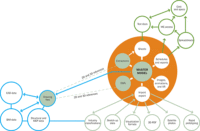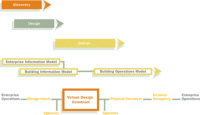From its founding in 1988, the Amsterdam-based UNStudio worked to tame the digital monster by using judicious understanding and historical precedent, abstractly applied. Early on, the studio, led by the authors, Ben van Berkel and Caroline Bos, realized that the formal methods for controlling parametric design were not the same as those of architecture’s centuries-old geometrical and proportional applications. The division of the design program into spatial elements and those spaces’ careful composition had given way to a topological mathematics of surface.
Taking the Möbius strip as the common denominator of their experiments, UNStudio found in the strip’s looping continuous surface a model for the distributed forms of domesticity as they changed and shifted from day to night. The result was the Möbius House of 1998 in Het Gooi, the Netherlands. With great ingenuity and an innovative plasticity, the studio then developed this matrix into an interlocking circulation route for the Mercedes-Benz Museum, which opened in Stuttgart, Germany, in 2006.
Now, employing their accumulated knowledge in a compendium of 400 pages, van Berkel and Bos have developed a guide that not only serves as a record of their own practice and approaches to design, but acts as a primer for any office concerned with controlling the parametric with acuity and architectural force.
The studio’s approach is refreshingly down-to-earth in a moment when fictions about the “parametric style” are flooding the internet with fake news of innovation. The book’s chapters deal with the tools required for what the authors call “the twist,” “the managed void,” and “the big detail” (which includes ceilings and stairs, roofscapes and facades).
A well-thought-out historical introduction sets the scene: a profession trained to deploy design in the service of single buildings is now called upon to display expertise in a widening range of tasks. This expanding role, the authors say, is performative—in the sense of forecasting what design does and in developing a hybrid knowledge that draws its force from a wide range of formerly distinct disciplines. The 11 “tools” relate to the work of UNStudio and are framed according to the dominant characteristics of its projects.
This is at once a version of an oeuvre complète in the process of being assembled (the lesson of Le Corbusier has been well learned) and a “how-to” manual on the order of a Bucky Fuller handbook or even the old- fashioned composition treatises handed out to the Beaux-Arts students.
The difference between these two examples, of course, is in the level of technical and technological knowledge being applied, and the complexity of the interrelations among the 11 knowledge tools. Here, perhaps, following the exhilarating journey through the firms’ trajectory over many decades, we might want a smaller and more concise guide to the new world of information and its potential controls. Regarding the book’s graphics, a little more control of color (digital “color” is at best a poor version) and a more sober use of blowups and scale changes would have led to a less giddy ride.
This said, I have yet to come across the equal to this investigation of the recent past and the potential future; and I have yet to find a firm as knowledgeable, and as aware of the appropriateness of differing scales and movements in urban design.
Whether one stands on UNStudio’s Erasmus Bridge (1996) that leads to the old transatlantic terminals of Rotterdam—with its extraordinary tension of cables and support—or spirals down the ramps of the Mercedes-Benz Museum, the control of the architect seems ever-present, refusing to be coerced by the hyperdramatics of Grasshopper or the deceiving perspectives of Maya software. This book demonstrates how these works were achieved, and endows them, if not with “theory” in the conventional sense, with a narrative of process.





